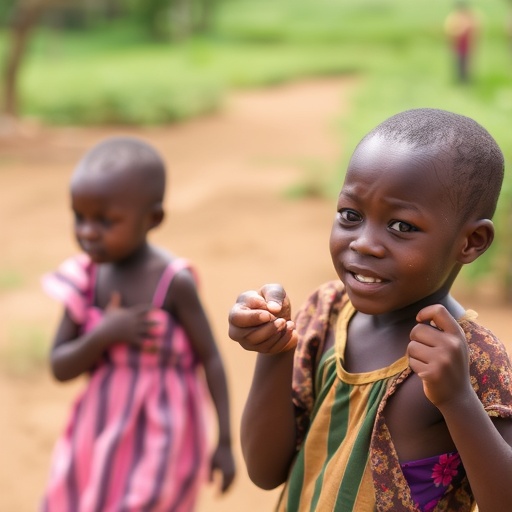In the heart of Tanzania lies a perplexing agricultural and nutritional conundrum that has left experts searching for answers. Known colloquially as the “breadbasket regions” (BBRs), these five powerhouse agricultural areas produce over 38% of the nation’s maize supply, yet paradoxically, they register the highest rates of child stunting and severe malnutrition in the country. This unexpected and counterintuitive phenomenon, dubbed the “breadbasket paradox,” challenges conventional wisdom, raising critical questions about the relationship between local food production and child health.
Recent investigative research led by Professor Xu Tian from China Agricultural University’s College of Economics and Management, in collaboration with Mosses Lufuke of the University of Dodoma’s Department of Economics, has shed light on this enigma. Utilizing an extensive dataset drawn from multiple nationally representative surveys—including Tanzania’s 2017–2018 National Household Budget Survey, the 2020–2021 National Integrated Labor Force Survey, and the 2020–2021 National Panel Survey—the team analyzed data encompassing 7,360 households. This robust yet nuanced approach allowed them to move beyond earlier descriptive studies toward a more rigorous quantification of the linkage between household food production and the nutritional status of children.
The study employed advanced econometric techniques, including Propensity Score Matching (PSM) and instrumental variables, to control for confounding influences such as household income, family size, and rural-urban distinctions. By statistically isolating the effect of crop production on child growth outcomes, the researchers verified the persistence of the paradox: children in Tanzania’s BBRs suffer from stunting at significantly higher rates than counterparts in non-BBRs, even when production levels are elevated. Contrastingly, non-BBR households exhibited clear nutritional benefits from increased food production, highlighting a disconcerting divergence.
This disparity provokes an examination of underlying causal mechanisms that may decouple agricultural abundance from nutritional gains. One hypothesis proposed and tested was the potential impact of maternal labor patterns: could intensified agricultural production compel mothers to devote more hours to farming activities outside the home, consequently reducing the time available for child care? Surprisingly, the analysis found no statistically significant association between crop production levels and maternal out-of-home working hours in either BBR or non-BBR regions, discrediting this avenue as the primary driver behind the paradox.
A second, more compelling mechanism identified relates to dietary diversity within households. In non-BBR areas, increased agricultural output correlated positively with enriched household diets, characterized by a broader assortment of foods essential for child growth and development. However, in the BBRs, despite the high volume of crop production, dietary diversity stagnated. This phenomenon is attributed to the intense agricultural commercialization prevalent in these regions, where farmers overwhelmingly prioritize monocultural cash crops intended for market sale rather than cultivating a varied range of crops for personal consumption. Such specialization leads to a nutritionally impoverished dietary profile for these families, despite their agricultural productivity.
The findings underscore a critical insight: the mere augmentation of food production is insufficient to combat child malnutrition and stunting, especially in contexts dominated by commercial agriculture. This underscores a fundamental flaw in existing agricultural policies, which tend to prioritize yield maximization over nutritional quality and dietary balance. By overlooking dietary diversity, current strategies inadvertently sustain malnutrition, even amidst food surpluses.
In light of this, the research proposes recalibrated policy directions to address the multifaceted dimensions of child nutrition in Tanzania’s BBRs. Firstly, it advocates for the encouragement of diversified crop cultivation to harmonize economic returns with household nutrition needs. This approach may entail incentives or guidance supporting farmers to integrate nutritious food crops with cash crops, thereby enhancing on-farm food variety available for family consumption.
Secondly, strengthening agricultural product markets is vital to enable households to monetize cash crop production effectively, allowing them to purchase a broader spectrum of foods. Improved market infrastructure, fair pricing mechanisms, and strengthened supply chains could empower farmers to convert agricultural profits into dietary diversity rather than rely solely on monoculture outputs.
Thirdly, resource allocation within households demands attention, particularly concerning women’s workloads. The study suggests that alleviating the burden of non-agricultural tasks—such as fetching water—could free up crucial time for women to prepare varied and nutritious meals, directly benefiting child growth outcomes. Social support systems and infrastructural improvements could therefore play pivotal roles in this respect.
The research advances our understanding of the intersection between agriculture, economic behavior, and public health. It exemplifies how macro-level productivity gains may not translate into expected welfare improvements without attention to socio-economic and cultural factors shaping household food utilization. By employing rigorous statistical models and comprehensive data, the study offers a clarion call for nuanced, integrated policy frameworks that simultaneously address production, consumption, and social dynamics.
Beyond immediate policy implications, the findings prompt a broader reevaluation of development narratives that equate food quantity with food security and nutrition. The Tanzania breadbasket paradox reveals that food security encompasses not only availability but also accessibility, utilization, and sustainability. Ensuring healthy child development demands interventions spanning agricultural diversification, market reforms, gender equity, and social infrastructure.
As global challenges such as climate change, population growth, and dietary transitions intensify, understanding complex local dynamics like those in Tanzania’s BBRs becomes indispensable. This research paves the way for targeted, evidence-based strategies aimed at breaking the cycle of malnutrition within key food-producing zones, thereby contributing to national and global goals for child health and sustainable development.
Ultimately, unraveling this paradox transcends Tanzania’s borders, offering valuable lessons for other regions grappling with similar tensions between agricultural productivity and nutritional well-being. It highlights the imperative for multidisciplinary approaches encompassing economics, agronomy, public health, and social policy to holistically address malnutrition in an era of unprecedented challenges and opportunities.
Subject of Research: Not applicable
Article Title: Unraveling the paradox of child growth in Tanzania’s breadbasket regions: impact of household food production
News Publication Date: 28-Jul-2025
Web References:
https://journal.hep.com.cn/fase/EN/10.15302/J-FASE-2025645
References:
DOI: 10.15302/J-FASE-2025645
Image Credits:
Credit: Mosses LUFUKE 1, 2, Xu TIAN 3
Keywords:
Agriculture




